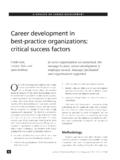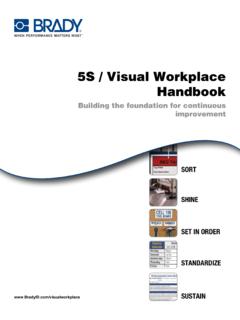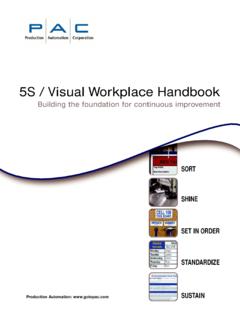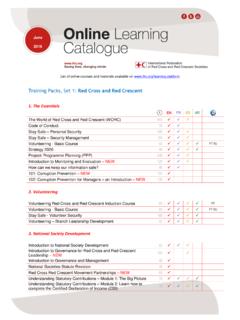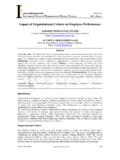Transcription of Communication and conflict in organizations: revisiting ...
1 conflict is a persistent fact of organizational life. Situations ofconflict in organizations are not always or even usually thedramatic confrontations that receive most attention and pub-licity strikes, walkouts, firings. Nor is conflict usually brack-eted into discrete public forums where negotiation and desig-nated third parties officially participate in the resolution ofdifferences. Rather, disputes are embedded in the interactionsbetween members as they go about their daily round of Communication is fundamental to an organization ,then so is conflict . They have a symbiotic relationship conflict cannot occur without Communication andhelps to broaden the context of Communication . Accordingto Galbraith, The modern corporation is socially a the-ater of all the conflicts that might be expected when hun-dreds and thousands of highly charged, exceptionally self-motivated, and more than normally self-serving peoplework closely together.
2 2 Factors that affect communicationModern symbolic interactionists hold that at least threefactors affect the meaning we attribute or ascribe to socialobjects ongoing negotiations, background characteristicsof the social objects, and external stimuli. But there aremore factors involved: our world views, past experiences,aspirations and expectations also affect what and how wecommunicate and how we react to the communicationreaching us. These factors are individually specific andalmost always culturally based. They can be a major causeof differences in the interpretation of and reaction to com- munication content differences that can lead to intraorga-nizational and/or interpersonal conflict . An example ofhow cultural orientation can affect Communication withinan organization is reflected by Sang Lee et al:The cultures of corporations find visual and symbolicexpression in logos, slogans, and rituals.
3 But such concretemanifestations have little meaning for Korean employees,whose cultural tradition is introspective and not of communicationThe Communication impact model (Figure 1) showshow the Communication content and its understandingcreate either positive or negative relationships betweenindividuals and draws attention to the importance ofOptimum, The Journal of Public Sector Management Vol. 28, No. 2 (1-10) Communication and conflictin organizations: revisitingthe basicsAndrew A. Moemeka1 Coorientation can help organizations toreduce misunderstanding and conflict ,thereby improving their Moemeka (PhD) is Professor and Chair of the Departmentof Communication at Central Connecticut State University in NewBritain, CT. knowing the audience. 4 Knowledge of predispositionshelps in constructing messages that fit well into the socio-cultural realities of the receiver s situation.
4 A communicatorwho knows and understands these predispositions is morelikely to succeed than a communicator who sends mes-sages to audiences/persons whose predispositions are notOptimum, The Journal of Public Sector Management Vol. 28, No. 2 Communication AND conflict IN ORGANIZATIONS: revisiting THE BASICS2 FIGURE 1 Communication impact modelSource: Moemeka communicators are affected by their individual backgrounds, as well as by their individual intentions, objectives and B has to deal with the effect of the message separately and react on the basis of her perception of its meaning and inten-tion. Built into the sender s message are: what he wants her reaction to be what he expects the reaction to lead to what the expected outcome of the message should receiver s understanding of the message will determine the effect of the message, her reaction and behavior toward, and ultimaterelationship with, the resultant relationship is determined mainly by the relationship between the contentof the sender s message and the receiver s under-standingof the message, and strengthened by the receiver s reactionto the message and behavior toward the sender.
5 Cultural orientation Past experiences Aspirations Intention Objective ExpectationCommunicator A(sender)Resultantrelationship Cultural orientation Past experiences Aspirations Intention Objective ExpectationCommunicator B(receiver)MessagecontentMessageundersta nding Effect Reaction Behavioradequately known the shot-in-the-dark approach to com- munication known as the information-dumping a sure way of creating misunderstanding and souringrelationships of creating conflict organization members must interact and orga-nizations need such interaction to be productive, severaldifferent models for reducing or even eliminating conflicthave been proposed by theorists. But many of thesemodels and prescriptive formulations seem ineffectual orirrelevant. In their study, Hidden conflict in Organizations,Kolb and Bartunek observed that most of the conceptsadvanced in formal studies of conflict did not help them tomake sense of what they found in their field research.
6 It became clear to us that conflict was embedded inthe routine and mundane activities of the work settings andthat it was rarely officially acknowledged or managed inthe ways most conflict models suggest. 6 These models ignore or relegate to the background afundamental of productive human relationship under-standing which is invariably achieved through acquiringadequate knowledge of the predispositions of the commu-nicating partners and forms the cornerstone of the informaltactics of conflict resolution that obtain among organizationmembers. Creating mutual understanding is the fundamen-tal role of Communication . Its perspectives and contexts areexplained by the coorientation theory, which can helporganizations reduce the incidence of unnecessary andavoidable conflict and save time and energy for coorientation theoryThe coorientation theory on conflict and communica-tion in organizations has been all but forgotten, eventhough most of its constructs are used in every act of com- munication .
7 Its basic tenet mutual understanding remains a key concept in effective Communication . The rel-evance of coorientation to organizations trying toavoid/reduce unnecessary conflict in order to improve per-sonnel as well as organizational performance is the basis ofthis article. The greatest ability in business is to get alongwith others and influence their actions. 8 Effective Communication means achieving the pur-pose for which a Communication content was constructedand sent. There are few more important requirements inorganizations than effective Communication , for the cor-rect performance of activities, positive relationshipsbetween and among organization members, attainment ofgoals and overall improvement of organizational perfor-mance all depend on it. But effective Communication isimpossible to achieve unless there is mutual understand-ing of Communication content and context what is said,who said it, why, what is expected, by whom, where,when, how and with whom, etc.
8 The communicationcontent may be rejected or accepted and its demandscarried out, but the reaction must be based on under-standing of the content and demands of the treats understanding rather than persua-sion as the basis of Communication . The theory asserts thatin order to accept or reject a message, we must first under-stand the content and context of that message. It is onlywhen we understand that we can react a summary of the assumptions behind thisapproach to analyzing Communication relationships,McLeod and Chaffee noted:The key assumption underlying this approach is that aperson s behavior is not based simply upon his private cogni-tive construction of his world; it is also a function of his per-ceptionof the orientations held by others around him and ofhis orientation to them under conditions of interaction, theactualcognitions and perceptions of others will also affect hisbehavior.
9 9 According to Cutlip et al, the coorientational measure-ment of an organization s Communication climate involvesfour questions: How does management define and evaluate the issueat hand? How does management think workers/labour defineand evaluate the issue? How do the workers/labour define and evaluate theissue? How do workers/labour think management definesand evaluates the issue?10A fifth question may be added: How similar or dissimilar is management s definition tothe workers definition?Optimum, The Journal of Public Sector Management Vol. 28, No. 23 Communication AND conflict IN ORGANIZATIONS: revisiting THE BASICSThis question deals with the extent of agreement betweenthe two. (See Figure 3, a structural model for answeringthese questions and analyzing the answers.)Few organizational communicators consciously usecoorientation or even discuss it as a theory, yet it meetsthe three criteria parsimony, accuracy and pervasive-ness that determine the superiority of one theory overanother.
10 Coorientation is parsimonious in structure and hasvery few specific and clearly directed related state-ments that summarize its perspective. It uses only fourmain concepts congruency, incongruency, accuracyand inaccuracy. It explains effective Communication phenomena moreaccurately than other theories; for example, if you donot understand, you cannot accurately and articulatelyrespond. Its explanatory power is pervasive and can explain avariety of Communication situations workplace inter-actions; Communication between friends and familymembers; and even international importance of understandingEvery Communication situation involves at least twoparties. The content of any exchange of ideas (communica-tion) between them is subject to individual examination todetermine the precise meaning of the Communication toeach of them.
